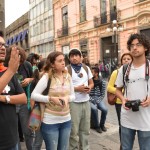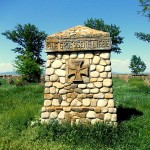Photos of destroyed heritage
Wouldn’t anyone like to see what the seven wonders of the ancient world looked like exactly, visit the Alexandria library, experience cultural heritage. Unfortunately that is not possible for many cultural heritage objects because, in time, they have been destroyed and we don’t have access to a time machine to visit them ourselves.
However, two inhabitants of the Ukrainian city of Lviv tried to give people the opportunity to see what some of the destroyed heritage objects looked like – the architect Yuri Voloschak and a photographer Volodymyr Olkhomyak. They uploaded pictures of lost monuments as part of Wiki Loves Monuments: lost pieces of history – unique, non restorable.
Yuri Voloshchak uploaded his own photos of a destroyed house in Lviv, which was a historic monument. A composer Yaroslav Yaroslavenko lived there. On September 10, 2008 a new owner demolished it to build a multi-storey building. It is curious that the street is named after the composer … but even his house was not left.
Volodymyr Olkhomyak has uploaded three historic photos. They show two churches:
– A timber Assumption Church in Yavoriv which was an architectural monument of national significance. It was built in 1670, but it burnt down on January 3, 2008 [6] [7] [8].
– A church of St. Paraskeva and its bell tower in Shklo, Yavoriv Raion. The church was built in 1732. The church and bell tower were simultaneously burnt on July 24, 2006 [9] [10].
Has everything that was built to last forever, lasted forever? Definitely not … Everything passes, this is not the thing to argue. Time grinds everything to dust and earth – people, things, mountains, beautiful and ugly things – all are equal for Him. Only a mention, a shadow of the shadow is left. And only memory remains. Passed on, preserved, told. A Wikipedia article cannot replace lost buildings. Of course. But – somehow – it is a memorial table not made by hands, a memory that can be seen, read and known. Will a photograph stored in the dusty home archive, have this chance too? It will be seen only by some relatives, friends, acquaintances – is it really the right place for our memory?
Servers’ memory is shamelessly cheap. And it gives the same opportunity of equal access for all. And it can be used as a backup – it is definitely more secure than a PC. Or keeping the photos among papers . Please, do not let the moments to be stuffed “in drawers”. Bring them to the light of a day and to the attention of thousands of people. “Manuscripts do not burn”, but they are not meant to be kept in the drawers…
It is not scary to press “Upload photo “. It is scary if it will never be done. And the only thing remained about a lost monument for future generations will be a set of sentences in a book: It was. Got burnt. Exists no more…
This blog post is based on an original blog post by Antanana, Wikimedia Ukraine. You can find the original blog post in Ukrainian on the national website of Wiki Loves Monuments Ukraine.




